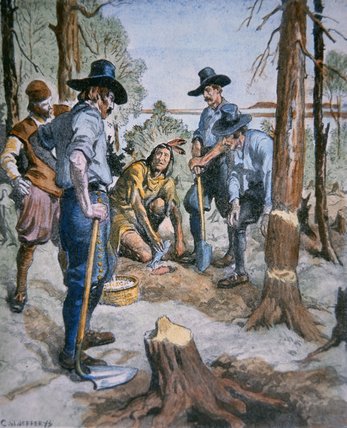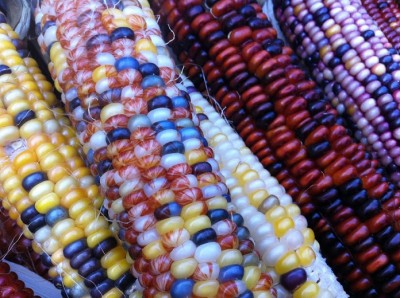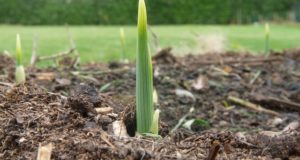 How many of us have sisters we can truly count on? One or more who will be by our side rain or shine? You may be wondering how sisters and gardening go together, but it seems they always have for Native Americans. The ancient method called Three Sisters gardening is a proven method for healthy bounty and successful vegetable growing. You can grow three vegetables – corn, beans and squash – in an efficient and earth-friendly way. It’s the method the Native Americans taught the Pilgrims, and it’s the method that thousands of people still use each spring.
How many of us have sisters we can truly count on? One or more who will be by our side rain or shine? You may be wondering how sisters and gardening go together, but it seems they always have for Native Americans. The ancient method called Three Sisters gardening is a proven method for healthy bounty and successful vegetable growing. You can grow three vegetables – corn, beans and squash – in an efficient and earth-friendly way. It’s the method the Native Americans taught the Pilgrims, and it’s the method that thousands of people still use each spring.
A Little Bit of History
Three sisters gardening provides a healthy diet and long-term fertility of garden soil. It was a system of gardening that native people perfected before the first European stepped onto the New World. Native people grew a wide selection of plants which often were drought-resistant and adaptable. Gardens were more of a small field or clearing. This would be big enough to grow produce for seeds the next year, as well as for food. Seeds would be gathered and stored, and it has been recorded by the early settlers how the native people would store ground maize to use during the winter.
They looked for signs in nature as to when to begin planting. For example, when the Canadian geese returned or the Dogwood tree’s leaves were the size of a squirrel’s ear, the soil was warm enough to plant seeds. They grew variations of today’s Three Sister gardens. Maize was the common corn.
Need Non-GMO Heirloom Seeds For Your Spring Garden? The Best Deals Are Right Here!
At the beginning of the planting season, there would be ceremonies. A festival would be held for the harvesting of the first green corn on the cob. Men and women had specific roles in the garden.
So, why do corn, squash and beans get planted together in this type of garden?
Traditionally, the native people viewed the Three Sisters — corn, squash, and beans — as a gift from the gods. These three vegetables were important both physically and spiritually to every tribe. There were several different tribes, with their own variations of the story behind the three sisters, leading to different methods of gardening. In every one, however, each plant had a significant role. Scientifically, these three plants nutritionally complement each other. Corn has the carbs, beans have the protein and squash has vitamins and oils. Corn provides a pole for the beans to climb and in turn, bean vines stabilize the corn stalks and also provide nitrogen in the soil for the corn. Squash plants are prickly enough to deter predators. Squash also acts as a ground-covering mulch and prevents weeds from growing. Squash also helps the soil retain moisture. All leftovers can be put back into the soil at the end of the season.
Planting Your Own Three Sisters Garden
Planting a Three Sisters garden is slightly different than the common garden style we know of today. Find an area with a minimum space of 10 X 10 square feet. This ensures good corn pollination. The site needs to be in the sun. Plants will need six to eight hours of sunlight a day. Put compost or manure in the soil — or fish, if you truly want to follow native methods.
You can sow seeds once the night temperatures are about 50 degrees Fahrenheit. This usually happens in middle to late spring to June.
This New All-Natural Fertilizer Doubles Garden Production!
Include pole beans or runner beans, as well as squash or pumpkins (both have vines, rather than bush.)
How to Plant a Three Sisters Garden
There are many ways to plant a Three Sisters garden, but here is one:
- Choose the type of corn, squash/pumpkin and bean to plant.
- Make mounds for your beans and corn. The center of each mound should be five feet from the next mound’s center.
- Mounds should be 18-24 inches across with flat tops. Plant the corn with four seeds in the center of a mound, and when the plants are about four inches tall, plant the squash and beans (at the same time).
- Plant about four beans in a circle around each corn stalk. (Make sure you weed the ground before planting.)
- Plant several squash seeds in a circle around the beans. Once the plants start growing, thin the mounds down to allow the stronger plants to grow.
Success for this garden depends on the spacing of seeds, timing of planting and the variety of crops. Do not plant too many seeds together or the vines will snarl into a mess and the corn will be smothered or crushed. Three Sisters gardening combines food, gardening, culture and history, making this gardening experience one-of-a-kind.
Have you ever planted a Three Sisters garden? What advice would you add? Share it in the section below:
Every Spring Gardeners Make This Avoidable Mistake — But You Don’t Have To. Read More Here.
 Off The Grid News Better Ideas For Off The Grid Living
Off The Grid News Better Ideas For Off The Grid Living




